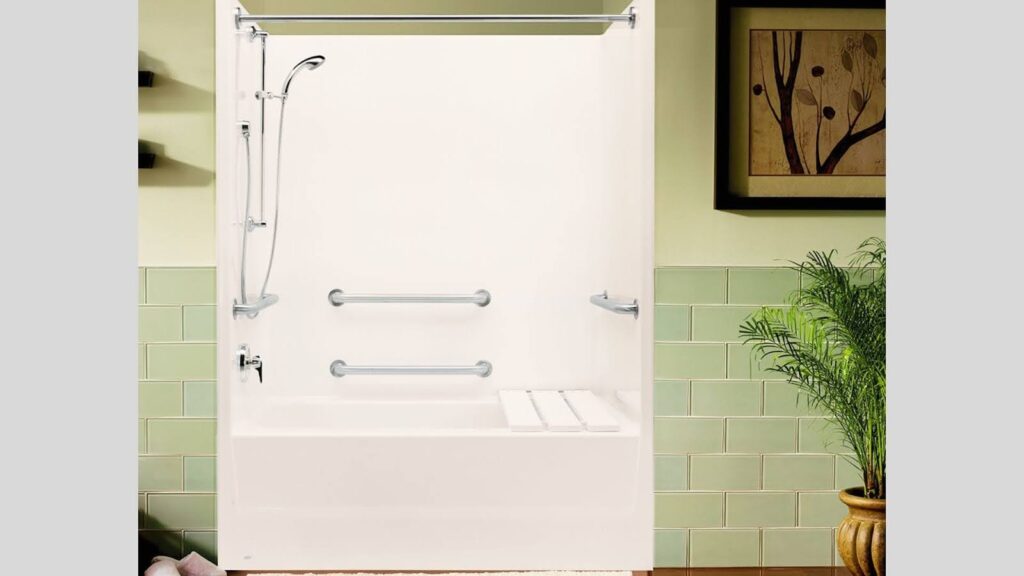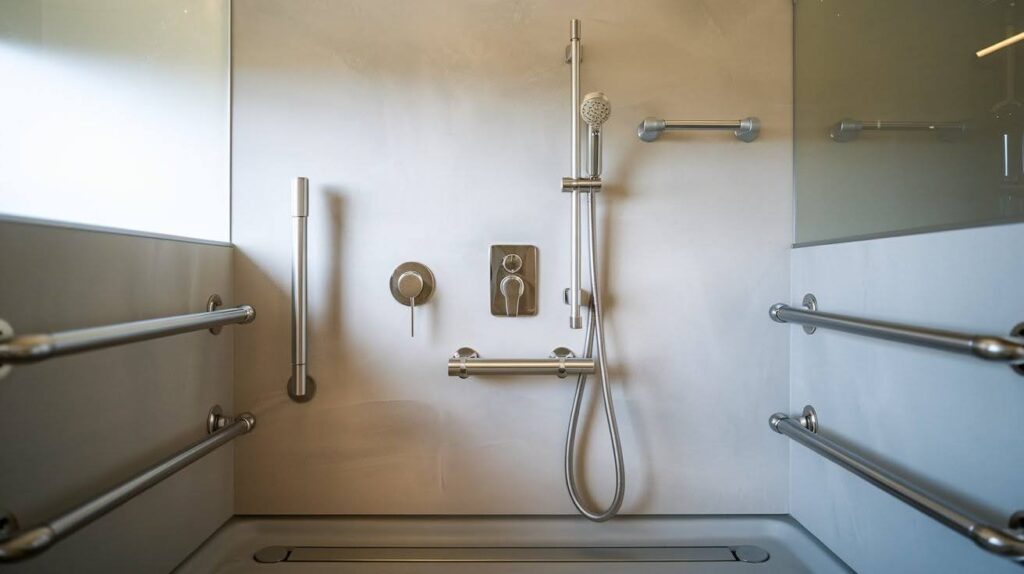Getting ADA shower valve requirements right can feel confusing. I’ve seen too many bathrooms fail inspections because the valves were placed incorrectly.
This guide shows you exactly where to put shower valves and controls to meet ADA standards.
You’ll learn the specific heights, distances, and placement rules for three types of showers: transfer-type, standard roll-in, and alternate roll-in.
I’ll cover valve operation requirements, spray unit specs, and clearance needs.
By the end, you’ll know how to create a safe, accessible shower that passes inspections and serves everyone properly.
Why Shower Valve Placement Matters

Proper valve placement keeps people safe and independent. When controls are too high or too far away, users with disabilities can’t reach them. This creates dangerous situations.
Wrong placement leads to scalding risks. People lose balance trying to reach controls. Falls happen more often.
Correct placement follows federal ADA regulations. Your facility stays compliant. Users gain confidence and independence.
Good valve placement works for everyone. It makes public facilities more welcoming. Private homes become safer for all residents.
Understanding ADA-Compliant Shower Compartments
ADA standards define three shower types, each with specific valve placement rules. Knowing which type you have determines where controls must go.
Transfer-type showers measure 36 by 36 inches inside. Place the valve on the wall opposite the seat, 38 to 48 inches high, within 15 inches of the seat’s center.
Standard roll-in showers measure at least 30 by 60 inches inside. Without a seat, mount the valve above the grab bar, 38 to 48 inches high. With a seat, put it on the back wall near the seat, no more than 27 inches from the seat wall.
Alternate roll-in showers measure at least 36 by 60 inches inside. With a seat, place the valve on the side wall next to it, 38 to 48 inches high, within 27 inches of the seat wall.
ADA Valve and Faucet Design Requirements

Valves must work easily for people with limited hand strength. Section 309.4 of the ADA sets clear rules for operable parts.
Operable Parts
Users must operate controls with one hand only. No tight gripping, squeezing, or wrist twisting allowed.
The valve should turn with 5 pounds of force or less. Lever handles work better than knobs.
Choose valves designed for easy use. Test them before installation.
Shower Spray Units
The hose must be at least 59 inches long. This length lets users hold the spray head comfortably.
The unit needs to work as both a fixed head and handheld spray. Users choose what works best for them.
Adding a vertical slide bar helps. The recommended range is 36 to 40 inches of adjustment.
Water temperature must max out at 120 degrees Fahrenheit. This prevents scalding injuries.
Exceptions and Special Cases
Some situations allow a fixed shower head at 48 inches. This applies to residential units and non-medical facilities.
Certain hotel guest rooms also qualify for this exception. Check local codes to confirm.
Guidelines on ADA Requirements for Shower Valves and Overall Bathroom Compliance
Meeting valve requirements is just one part of full ADA compliance. Your entire shower setup needs attention.
- Controls must fall within proper reach ranges and operate with one hand only. Shower spray units need a 59-inch hose minimum and should switch between fixed and handheld positions easily.
- Water temperature stays at or below 120 degrees Fahrenheit to protect against burns. Install grab bars at the correct height and location throughout the space.
- Clear floor space varies by shower type. Transfer showers need 36 by 48 inches while roll-in types require 30 by 60 inches.
- Transfer-type showers must have seats. Roll-in showers can include them optionally based on user needs.
- Thresholds in roll-in showers can’t exceed half an inch. Shower enclosures must not block controls or transfer areas.
Placement Considerations for Accessibility and Safety
Smart valve placement prevents accidents and improves usability. Think about how users will actually reach and operate controls.
Mount valves above grab bars when possible. This prevents obstruction and gives users support.
Keep controls within standard reach ranges. Users shouldn’t strain or overextend to turn water on and off.Never block grab bars with valves or fixtures. Don’t cover seats or transfer spaces either.
Maintain all required clear spaces. Users need room to position wheelchairs and walkers properly.
Test the layout before final installation. Imagine how someone seated would reach everything.
Common Questions and Practical Tips
Understanding different shower types and applications helps you make smart decisions during installation or renovation.
- Control placement differs based on your shower type. Transfer showers put valves opposite the seat. Standard roll-in showers vary by seat presence. Alternate roll-in types use side walls.
- Residential applications sometimes allow more flexibility. Commercial spaces must follow stricter rules.
- New construction offers easier compliance. You can plan spaces correctly from the start.
- Existing buildings present challenges. Sometimes you need creative solutions to meet standards without major renovations.
- Work with experienced contractors. They know how to adapt older spaces while maintaining accessibility.
Conclusion
I’ve renovated three bathrooms using these exact ADA standards, and each time the results made a real difference for the families using them.
ADA shower valve requirements protect people and create truly usable spaces. Getting the height right, choosing easy-to-operate valves, and maintaining proper clearances matters more than you might think.
When I see someone use a shower independently because the controls are placed correctly, it reminds me why these standards exist.
Ready to start your project? Check your local codes first, then consider hiring a certified ADA consultant for complex renovations.
Frequently Asked Questions
What height should ADA shower valves be mounted?
Shower valves must be mounted between 38 and 48 inches above the floor. This height range allows seated users to reach controls comfortably without straining or losing balance.
Do all ADA showers require handheld spray units?
Yes, ADA-compliant showers must include a spray unit with at least a 59-inch hose. The unit should function as both a fixed shower head and a handheld option for user flexibility.
Can I use round knobs for ADA shower valves?
No, round knobs require twisting and tight gripping. ADA standards require controls that operate with one hand and no more than 5 pounds of force, making lever handles a better choice.
What is the difference between transfer and roll-in showers?
Transfer showers are 36 by 36 inches and require users to move from a wheelchair to a built-in seat. Roll-in showers are larger, allowing wheelchairs to roll directly inside without transferring.
Do residential bathrooms need to follow ADA valve placement rules?
Private residences are not legally required to follow ADA standards unless they receive federal funding. However, following these guidelines creates safer, more accessible spaces for all residents and visitors.

